Utilizing Rare-Earth-Elements Luminescence and Vibrational-Spectroscopies to Follow High Pressure Densification of Soda–Lime Glass
Abstract
:Highlights:
- 1—Spectroscopic approach to detect the influence of permanent densification in glass.
- 2—Raman signal and REE are utilized as sensors.
- 3—Several calibration curves for these approaches are given.
- 4—Non-linear behavior of the Brillouin shift at early applied Pmax.
1. Introduction
2. Sample Preparation
2.1. Eu2O3 Doping of Commercial Low-Iron Soda–Lime Float Glass
2.2. Inducing Permanent Densification at Room Temperature
3. Experimental Methods
3.1. High Precision Density Determination
3.2. Acquisition and Data Treatment of the Raman-, Brillouin- and Luminescence-Spectra
3.2.1. General
3.2.2. Raman and Brillouin Experimental Setup
3.2.3. Raman Data Treatment
3.2.4. Brillouin Data Treatment
3.2.5. Nd3+- and Eu3+-Luminescence Acquisition
3.2.6. Neodymium Data Treatment
3.2.7. Europium Data Treatment
3.3. Characterization of Spectral Variations
4. Results & Discussion
4.1. Densification of Glass Cylinders
4.2. Permanent Densified Soda–Lime Glass Characterization
4.2.1. Raman Spectroscopy: Glass Structure Modification
4.2.2. Brillouin Spectroscopy
4.2.3. Nd3+ and Eu3+ Luminescence
4.3. Comparison and Sensitivity Assessment
5. Conclusions
Author Contributions
Funding
Institutional Review Board Statement
Informed Consent Statement
Data Availability Statement
Acknowledgments
Conflicts of Interest
Appendix A
| Densification | Δ | m | mf | Pinflection | Ponset | Pend |
|---|---|---|---|---|---|---|
| % | [a.u.] | % | [GPa] | |||
| This work | 3.55 (±0.14) | 0.14 (±0.02) | 0.50 (±0.09) | 14.5 (±0.3) | 10.9 (±0.8) | 18.1 (±0.8) |
| Ji et al. [6] † | 6.3 | 0.11 | 0.71 | 14.5 | 10.1 | 19.0 |
| Spectroscopic Method | [cm−1] | [a.u.] | [cm−1] | [GPa] | ||
| Raman main band | 5.16 (±0.21) | 0.16 (±0.03) | 0.83 (±0.19) | 14.6 (±0.3) | 11.5 (±0.9) | 17.7 (±0.9) |
| Raman Qn-region | −15.82 (±4.14) | 0.08 (±0.02) | −1.27 (±0.01) | 18.1 (±2.0) | 11.9 (±3.6) | 24.4 (±3.6) |
| Mean Nd3+ → 4F3/2 → 4I9/2 | −50.93 (±0.93) | 0.15 (±0.01) | −7.64 (±0.37) | 14.7 (±0.1) | 11.4 (±0.3) | 18.0 (±0.3) |
| Mean Eu3+ → 5D0 → 7F2 | −13.46 (±0.24) | 0.15 (±0.01) | −2.02 (±0.10) | 14.5 (±0.1) | 11.2 (±0.3) | 17.8 (±0.3) |
| Mean Eu3+ → 5D0 → 7F1 | 21.49 (±1.34) | 0.12 (±0.01) | 2.58 (±0.38) | 16.1 (±0.4) | 11.9 (±0.7) | 20.3 (±0.7) |
| Mean Eu3+ → 5D0 → 7F0 | 21.94 (±3.25) | 0.08 (±0.02) | 1.71 (±0.68) | 15.2 (±1.3) | 8.8 (±2.9) | 21.7 (±2.9) |
| Spectroscopic Method | Density | Error | R2 |
|---|---|---|---|
| main band | ρ = 0.01635* − 7.18 | 0.004 | 0.987 |
| Qn-region | ρ = −0.00892* + 12.09 | 0.008 | 0.938 |
| Centroid Nd3+ → 4F3/2 → 4I9/2 | ρ = −0.00183* + 23.06 | 0.018 | 0.970 |
| Centroid Eu3+ → 5D0 → 7F2 | ρ = −0.00686* + 113.97 | 0.034 | 0.983 |
| Centroid Eu3+ → 5D0 → 7F1 | ρ = 0.00485* − 79.49 | 0.060 | 0.953 |
| Centroid Eu3+ → 5D0 → 7F0 | ρ = 0.00529* − 89.01 | 0.008 | 0.964 |
| Pmax | Density | Densification | Densification Sigmoidal-Fit | Centroid Main Band | Centroid Qn-Region | Brillouin Shift | Centroid Nd3+ 4F3/2 → 4I9/2 (Hypersensitive) | Centroid Eu3+ 5D0 → 7F2 (Hypersensitive) | Centroid Eu3+ 5D0 → 7F1 | Centroid Eu3+ 5D0 → 7F0 |
|---|---|---|---|---|---|---|---|---|---|---|
| [GPa] | [g/cm3] | [%] | [cm−1] | [cm−1] | [GHz] | [cm−1] | ||||
| ±1 | ±0.002 | ±0.08 | --- | ±0.5 | ±0.5 | ±0.03 | ±1.0 | |||
| 0 | 2.505 | 0 | 0 | 586.0 | 1082.8 | 36.71 | 11,253.6 | 16,279.5 | 16,922.1 | 17,291.5 |
| 9 | 2.511 | 0.24 | 0.15 | 586.4 | 1082.2 | 36.51 | 11,250.1 | 16,278.5 | 16,924.6 | 17,293.7 |
| 12 | 2.520 | 0.60 | 0.70 | 587.5 | 1081.9 | 36.52 | 11,241.8 | 16,276.5 | 16,926.4 | 17,295.6 |
| 15 | 2.557 | 2.08 | 2.02 | 591.5 | 1079.5 | 36.66 | 11,217.4 | 16,269.1 | 16,939.0 | 17,299.3 |
| 19 I | 2.597 | 3.67 | 3.29 | 596.2 | 1075.8 | 37.24 | 11,197.0 | 16,262.4 | 16,955.1 | 17,303.1 |
| 19 II | 2.584 | 3.15 | 3.29 | 596.2 | 1074.9 | 37.17 | 11,192.4 | 16,261.4 | 16,959.2 | 17,302.2 |
| 21 | 2.594 | 3.55 | 3.46 | 596.5 | 1073.1 | 37.34 | 11,189.3 | 16,261.0 | 16,962.3 | 17,305.7 |
| Pmax | Density | Densification | Densification Sigmoidal-Fit | Mean Main Band | Mean Qn-Region | Brillouin Shift | Mean Nd3+ 4F3/2 → 4I9/2 (Hypersensitive) | Mean Eu3+ 5D0 → 7F2 (Hypersensitive) | Mean Eu3+ 5D0 → 7F1 | Mean Eu3+ 5D0 → 7F0 |
|---|---|---|---|---|---|---|---|---|---|---|
| [GPa] | [g/cm3] | [%] | [cm−1] | [cm−1] | [GHz] | [cm−1] | ||||
| ±1 | ±0.002 | ±0.08 | --- | ±0.5 | ±0.5 | ±0.03 | ±1.0 | |||
| 0 | 2.505 | 0 | 0 | 592.2 | 1074.3 | 36.71 | 11,222.2 | 16,254.2 | 16,918.4 | 17,296.7 |
| 9 | 2.511 | 0.24 | 0.15 | 592.1 | 1072.7 | 36.51 | 11,220.0 | 16,253.4 | 16,920.0 | 17,299.1 |
| 12 | 2.520 | 0.60 | 0.70 | 593.1 | 1072.6 | 36.52 | 11,213.3 | 16,251.7 | 16,920.8 | 17,302.2 |
| 15 | 2.557 | 2.08 | 2.02 | 595.0 | 1069.9 | 36.66 | 11,194.8 | 16,246.6 | 16,926.4 | 17,308.0 |
| 19 I | 2.597 | 3.67 | 3.29 | 597.7 | 1065.8 | 37.24 | 11,179.8 | 16,242.1 | 16,933.8 | 17,312.7 |
| 19 II | 2.584 | 3.15 | 3.29 | 597.2 | 1065.0 | 37.17 | 11,174.0 | 16,241.4 | 16,935.6 | 17,312.3 |
| 21 | 2.594 | 3.55 | 3.46 | 597.1 | 1063.2 | 37.34 | 11,173.3 | 16,241.2 | 16,937.8 | 17,316.1 |
References
- Serbin, J.; Oulundsen, G. Lasers Improve Display Glass Cutting. Inf. Disp. 2017, 33, 38–41. [Google Scholar] [CrossRef]
- Hermanns, C.; Middleton, J. Laser separation of flat glass in electronic-, optic-, display-, and bio-industry. Photon Process. Microelectron. Photonics IV 2005, 5713, 387–396. [Google Scholar] [CrossRef]
- Sellappan, P.; Rouxel, T.; Celarie, F.; Becker, E.; Houizot, P.; Conradt, R. Composition dependence of indentation deformation and indentation cracking in glass. Acta Mater. 2013, 61, 5949–5965. [Google Scholar] [CrossRef]
- Kato, Y.; Yamazaki, H.; Itakura, S.; Yoshida, S.; Matsuoka, J. Load dependence of densification in glass during Vickers indentation test. J. Ceram. Soc. Jpn. 2011, 119, 110–115. [Google Scholar] [CrossRef] [Green Version]
- Kubicki, J.D.; Hemley, R.J.; Hofmeister, A.M. Raman and infrared study of pressure-induced structural changes in MgSiO3, CaMgSi2O6, and CaSiO3 glasses. Am. Mineral. 1992, 77, 258–269. [Google Scholar]
- Ji, H.; Keryvin, V.; Rouxel, T.; Hammouda, T. Densification of window glass under very high pressure and its relevance to Vickers indentation. Scr. Mater. 2006, 55, 1159–1162. [Google Scholar] [CrossRef]
- Kato, Y.; Yamazaki, H.; Yoshida, S.; Matsuoka, J.; Kanzaki, M. Measurements of density distribution around Vickers indentation on commercial aluminoborosilicate and soda-lime silicate glasses by using micro Raman spectroscopy. J. Non-Cryst. Solids 2012, 358, 3473–3480. [Google Scholar] [CrossRef]
- Deschamps, T.; Margueritat, J.; Martinet, C.; Mermet, A.; Champagnon, B. Elastic moduli of permanently densified silica glasses. Sci. Rep. 2014, 4, 7193. [Google Scholar] [CrossRef] [Green Version]
- Deschamps, T.; Martinet, C.; Bruneel, J.L.; Champagnon, B. Soda-lime silicate glass under hydrostatic pressure and indentation: A micro-Raman study. J. Phys. Condens. Matter 2011, 23, 35402. [Google Scholar] [CrossRef]
- Rouxel, T.; Ji, H.; Guin, J.P.; Augereau, F.; Rufflé, B. Indentation deformation mechanism in glass: Densification versus shear flow. J. Appl. Phys. 2010, 107, 94903. [Google Scholar] [CrossRef]
- Rouxel, T.; Ji, H.; Hammouda, T.; Moréac, A. Poisson’s ratio and the densification of glass under high pressure. Phys. Rev. Lett. 2008, 100, 225501. [Google Scholar] [CrossRef]
- Gerbig, Y.B.; Michaels, C.A. In-situ Raman spectroscopic measurements of the deformation region in indented glasses. J. Non-Cryst. Solids 2020, 530, 119828. [Google Scholar] [CrossRef]
- Cohen, H.M.; Roy, R. Effects of Ultra high Pressures on Glass. J. Am. Ceram. Soc. 1961, 44, 523–524. [Google Scholar] [CrossRef]
- Cohen, H.M.; Roy, R. Densification of glass at very high pressure. Phys. Chem. Glasses 1965, 6, 149–161. [Google Scholar]
- Rodríguez-Mendoza, U.R.; León-Luis, S.F.; Muñoz-Santiuste, J.E.; Jaque, D.; Lavín, V. Nd3+-doped Ca3Ga2Ge3O12 garnet: A new optical pressure sensor. J. Appl. Phys. 2013, 113, 213517. [Google Scholar] [CrossRef]
- Perriot, A.; Barthel, E.; Kermouche, G.; Quérel, G.; Vandembroucq, D. On the plastic deformation of soda-lime glass—A Cr3+ luminescence study of densification. Philos. Mag. 2011, 91, 1245–1255. [Google Scholar] [CrossRef] [Green Version]
- Grinberg, M. Spectroscopic characterisation of disordered materials doped with chromium. Opt. Mater. 2002, 19, 37–45. [Google Scholar] [CrossRef]
- Muñoz-Santiuste, J.E.; Lavín, V.; Rodríguez-Mendoza, U.R.; Ferrer-Roca, C.; Errandonea, D.; Martínez-García, D.; Rodríguez-Hernández, P.; Muñoz, A.; Bettinelli, M. Experimental and theoretical study on the optical properties of LaVO4 crystals under pressure. Phys. Chem. Chem. Phys. 2018, 20, 27314–27328. [Google Scholar] [CrossRef]
- Frost, D.; Poe, B.; Trønnes, R.; Liebske, C.; Duba, A.; Rubie, D. A new large-volume multianvil system. Phys. Earth Planet. Int. 2004, 143–144, 507–514. [Google Scholar] [CrossRef]
- Yoshioka, T.; Wiedenbeck, M.; Shcheka, S.; Keppler, H. Nitrogen solubility in the deep mantle and the origin of Earth’s primordial nitrogen budget. Earth Planet. Sci. Lett. 2018, 488, 134–143. [Google Scholar] [CrossRef]
- Veber, A.; Cicconi, M.R.; Reinfelder, H.; de Ligny, D. Combined Differential scanning calorimetry, Raman and Brillouin spectroscopies: A multiscale approach for materials investigation. Anal. Chim. Acta 2018, 998, 37–44. [Google Scholar] [CrossRef]
- Kassir-Bodon, A.; Deschamps, T.; Martinet, C.; Champagnon, B.; Teisseire, J.; Kermouche, G. Raman Mapping of the Indentation-Induced Densification of a Soda-Lime-Silicate Glass. Int. J. Appl. Glass Sci. 2012, 3, 29–35. [Google Scholar] [CrossRef]
- Cicconi, M.R.; Khansur, N.H.; Eckstein, U.R.; Werr, F.; Webber, K.G.; Ligny, D. Determining the local pressure during aerosol deposition using glass memory. J. Am. Ceram. Soc. 2020, 103, 2443–2452. [Google Scholar] [CrossRef]
- Sen, P.N.; Thorpe, M.F. Phonons in AX2 glasses: From molecular to band-like modes. Phys. Rev. B 1977, 15, 4030–4038. [Google Scholar] [CrossRef]
- Neuville, D.R.; de Ligny, D.; Henderson, G.S. Advances in Raman Spectroscopy Applied to Earth and Material Sciences. Rev. Mineral. Geochem. 2014, 78, 509–541. [Google Scholar] [CrossRef]
- Weigel, C.; Mebarki, M.; Clément, S.; Vacher, R.; Foret, M.; Rufflé, B. Pressure-induced densification of vitreous silica: Insight from elastic properties. Phys. Rev. B 2019, 100, 094102. [Google Scholar] [CrossRef] [Green Version]
- Jørgensen, C.K.; Judd, B.R. Hypersensitive pseudoquadrupole transitions in lanthanides. Mol. Phys. 1964, 8, 281–290. [Google Scholar] [CrossRef]
- Binnemans, K. Interpretation of europium(III) spectra. Coord. Chem. Rev. 2015, 295, 1–45. [Google Scholar] [CrossRef] [Green Version]
- Hehlen, B. Inter-tetrahedra bond angle of permanently densified silicas extracted from their Raman spectra. J. Phys. Condens. Matter 2010, 22, 25401. [Google Scholar] [CrossRef]
- Martinet, C.; Heili, M.; Martinez, V.; Kermouche, G.; Molnar, G.; Shcheblanov, N.; Barthel, E.; Tanguy, A. Highlighting the impact of shear strain on the SiO2 glass structure: From experiments to atomistic simulations. J. Non-Cryst. Solids 2020, 533, 119898. [Google Scholar] [CrossRef]
- Mackenzie, J.D. High-Pressure Effects on Oxide Glasses: I, Densification in Rigid State. J. Am. Ceram. Soc. 1963, 46, 461–470. [Google Scholar] [CrossRef]
- Fluegel, A. Global Model for Calculating Room-Temperature Glass Density from the Composition. J. Am. Ceram. Soc. 2007, 90, 2622–2625. [Google Scholar] [CrossRef] [Green Version]
- Ayrinhac, S.; Rufflé, B.; Foret, M.; Tran, H.; Clément, S.; Vialla, R.; Vacher, R.; Chervin, J.C.; Munsch, P.; Polian, A. Dynamical origin of anomalous temperature hardening of elastic modulus in vitreous silica. Phys. Rev. B 2011, 84, 024201. [Google Scholar] [CrossRef] [Green Version]
- Sonneville, C.; Mermet, A.; Champagnon, B.; Martinet, C.; Margueritat, J.; de Ligny, D.; Deschamps, T.; Balima, F. Progressive transformations of silica glass upon densification. J. Chem. Phys. 2012, 137, 124505. [Google Scholar] [CrossRef]
- Grimsditch, M. Polymorphism in Amorphous SiO2. Phys. Rev. Lett. 1984, 52, 2379–2381. [Google Scholar] [CrossRef]

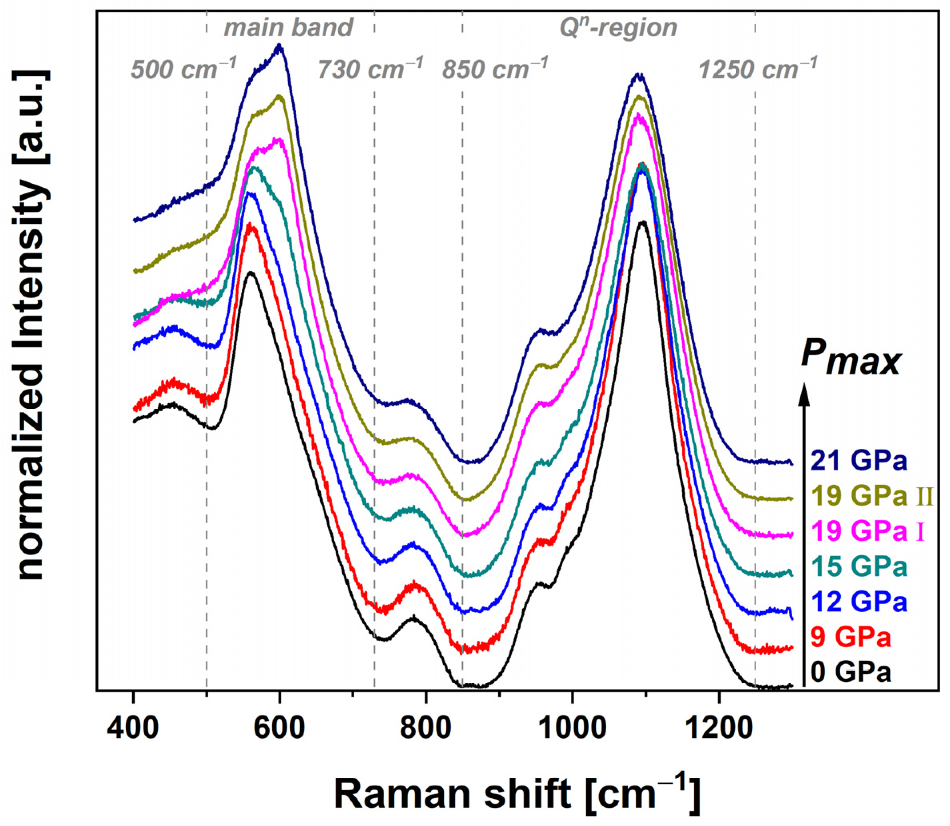
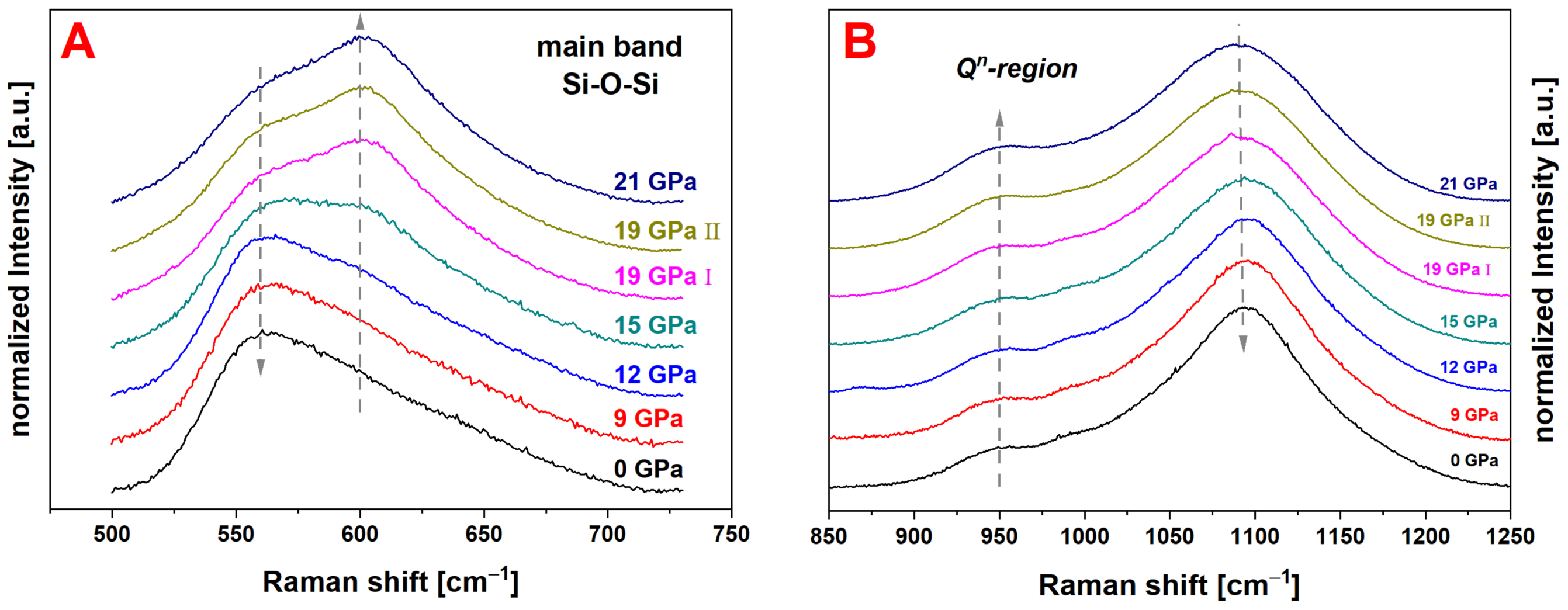

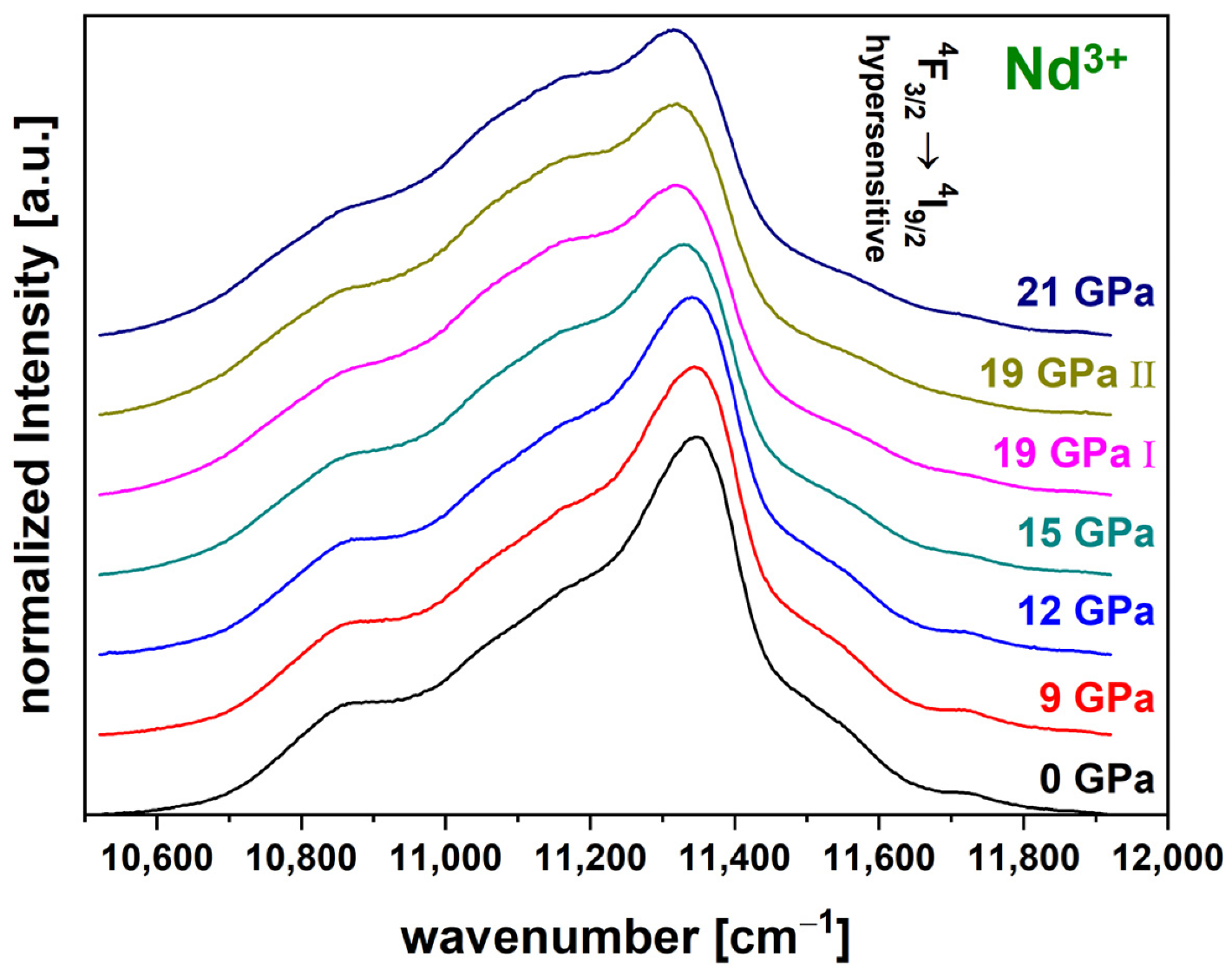

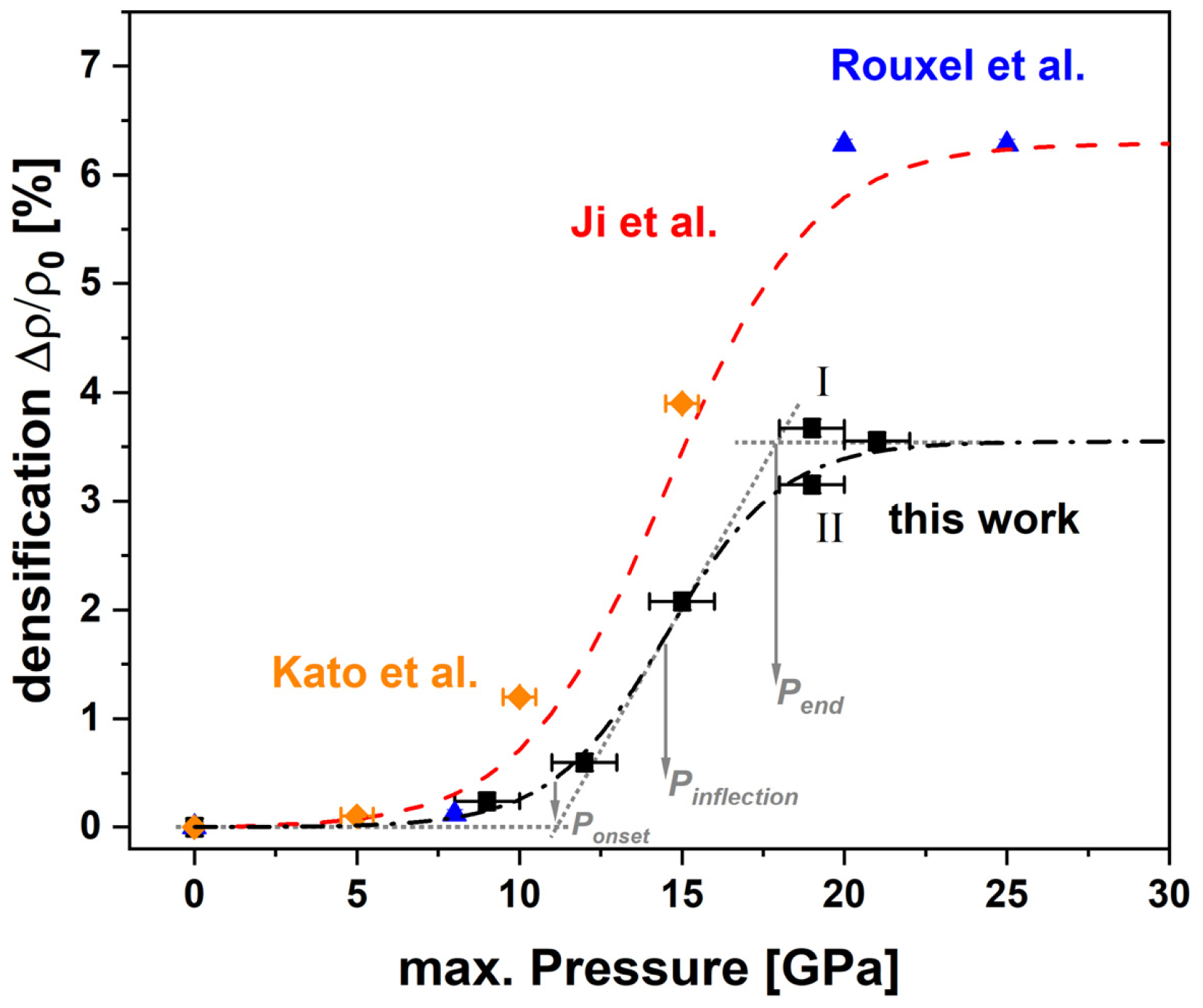
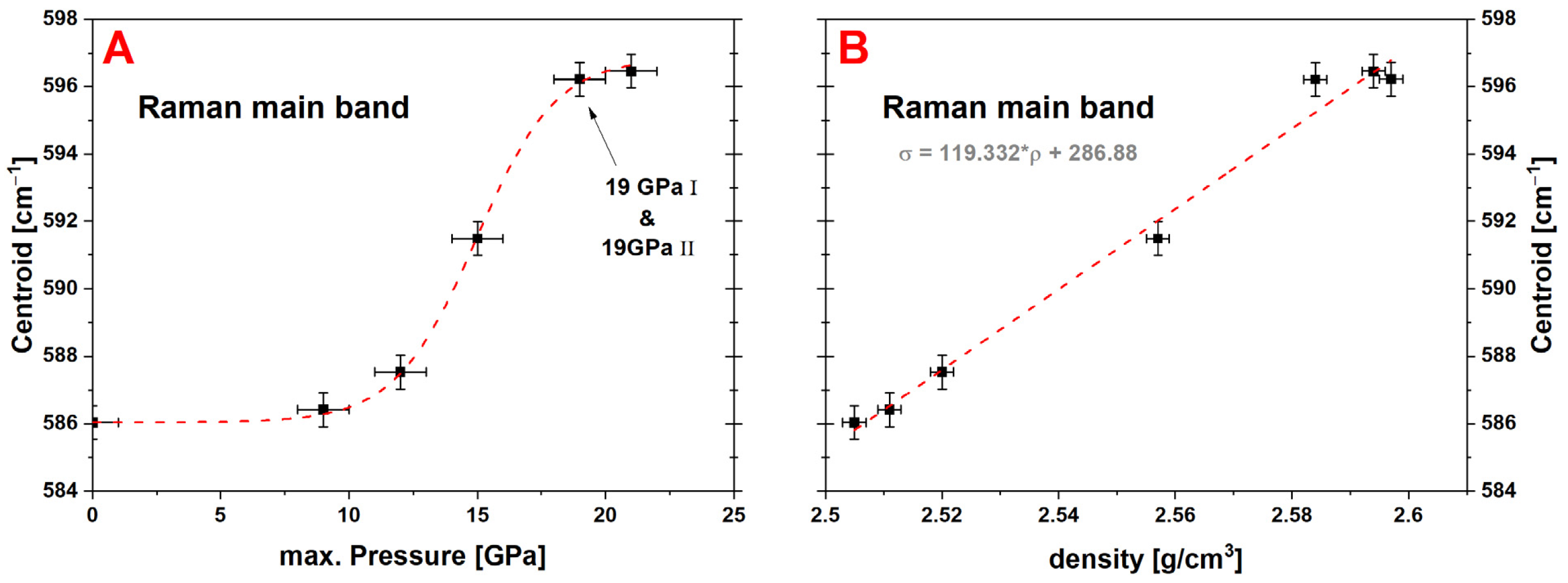
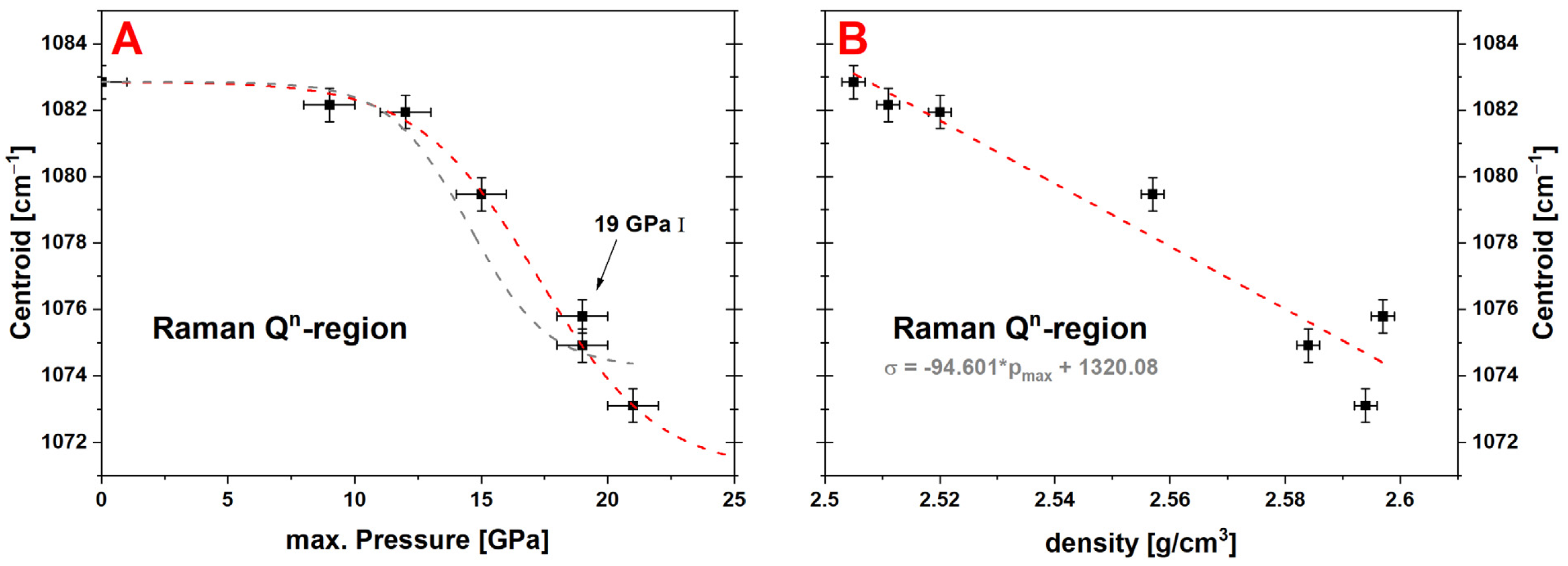
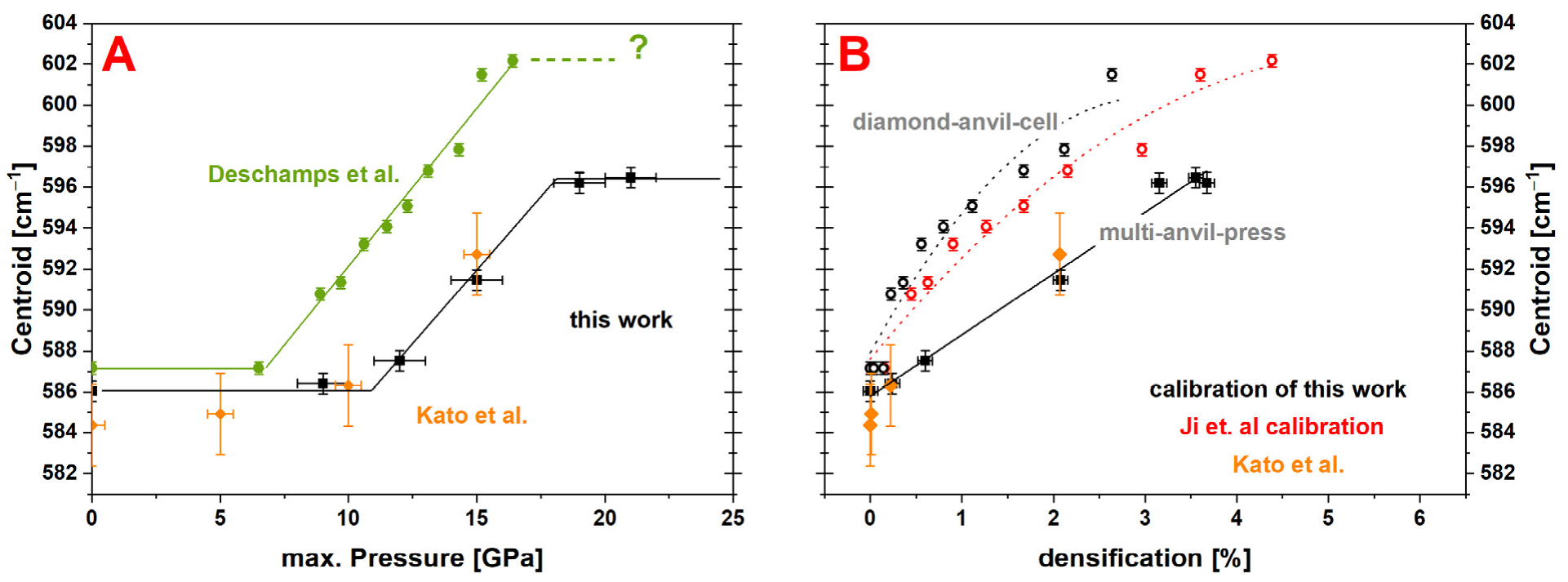
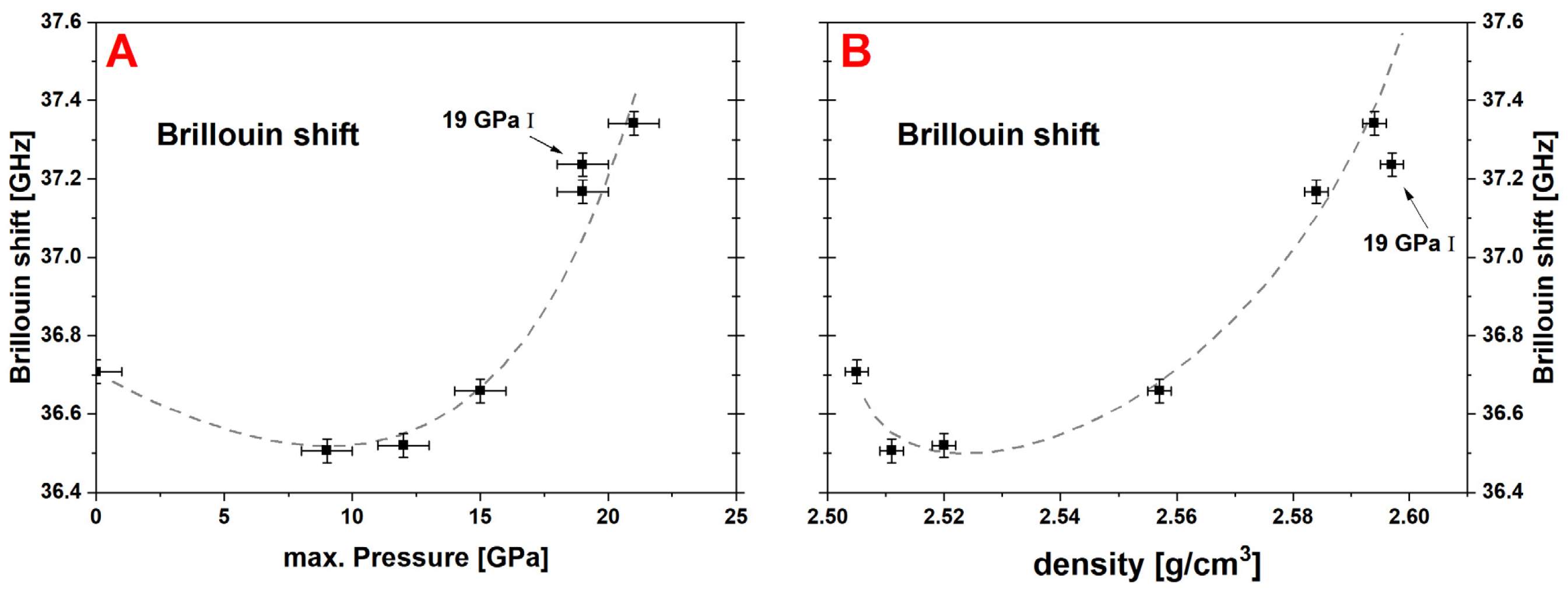
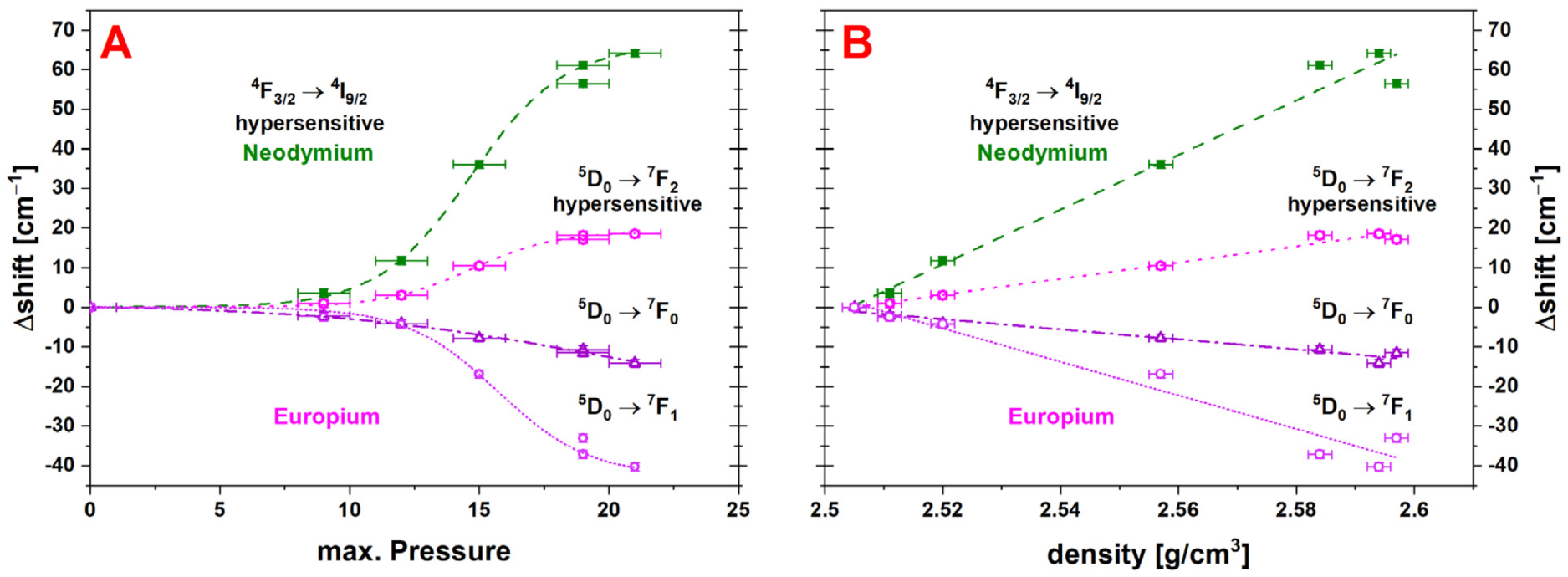

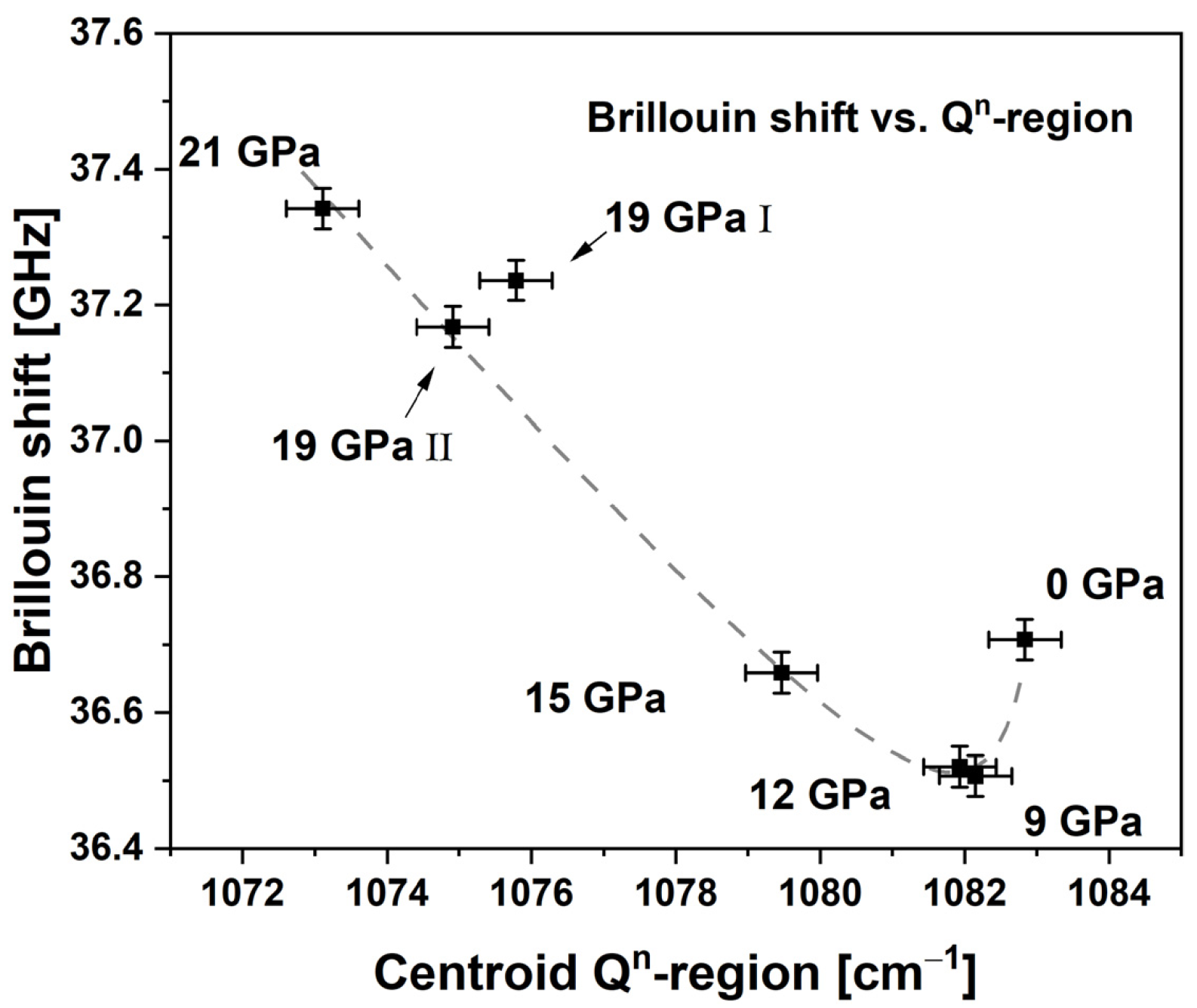
| Densification | Δ | m | mf | Pinflection | Ponset | Pend |
|---|---|---|---|---|---|---|
| % | [a.u.] | % | [GPa] | |||
| This work | 3.55 (±0.14) | 0.14 (±0.02) | 0.50 (±0.09) | 14.5 (±0.3) | 10.9 (±0.8) | 18.1 (±0.8) |
| Ji et al. [6] † | 6.3 | 0.11 | 0.71 | 14.5 | 10.1 | 19.0 |
| Spectroscopic Method | [cm−1] | [a.u.] | [cm−1] | [GPa] | ||
| Raman main band | 10.82 (±0.15) | 0.16 (±0.01) | 1.73 (±0.13) | 14.9 (±0.1) | 11.8 (±0.3) | 18.0 (±0.3) |
| Raman Qn-region | −11.69 (±1.03) | 0.11 (±0.01) | −1.29 (±0.01) | 17.2 (±0.6) | 12.7 (±1.0) | 21.7 (±1.0) |
| Centroid Nd3+ → 4F3/2 → 4I9/2 | −66.31 (±0.65) | 0.14 (±0.01) | −9.29 (±0.57) | 14.7 (±0.1) | 11.1 (±0.4) | 18.3 (±0.4) |
| Centroid Eu3+ → 5D0 → 7F2 | −19.10 (±0.35) | 0.15 (±0.01) | −2.87 (±0.14) | 14.7 (±0.1) | 11.4 (±0.3) | 18.0 (±0.3) |
| Centroid Eu3+ → 5D0 → 7F1 | 42.51 (±1.62) | 0.14 (±0.02) | 5.95 (±1.08) | 15.7 (±0.3) | 12.1 (±0.8) | 19.3 (±0.8) |
| Centroid Eu3+ → 5D0 → 7F0 | 24.12 (±15.30) | 0.05 (±0.02) | 1.18 (±1.25) | 19.3 (±6.4) | 9.3 (±11.1) | 29.7 (±11.1) |
| Spectroscopic Method | Density | Error | R2 |
|---|---|---|---|
| main band | ρ = 0.00828*σ − 2.35 | 0.004 | 0.988 |
| Qn-region | ρ = −0.00980*σ + 13.12 | 0.009 | 0.927 |
| Centroid Nd3+ →4F3/2 → 4I9/2 | ρ = −0.00142*σ + 18.48 | 0.009 | 0.979 |
| Centroid Eu3+ → 5D0 → 7F2 | ρ = −0.00479*σ + 80.54 | 0.059 | 0.983 |
| Centroid Eu3+ → 5D0 → 7F1 | ρ = 0.00226*σ − 35.69 | 0.047 | 0.957 |
| Centroid Eu3+ → 5D0 → 7F0 | ρ = 0.00749*σ − 126.94 | 0.070 | 0.957 |
Publisher’s Note: MDPI stays neutral with regard to jurisdictional claims in published maps and institutional affiliations. |
© 2021 by the authors. Licensee MDPI, Basel, Switzerland. This article is an open access article distributed under the terms and conditions of the Creative Commons Attribution (CC BY) license (https://creativecommons.org/licenses/by/4.0/).
Share and Cite
Werr, F.; Yusim, W.; Bergler, M.; Shcheka, S.; Lenhart, A.; de Ligny, D. Utilizing Rare-Earth-Elements Luminescence and Vibrational-Spectroscopies to Follow High Pressure Densification of Soda–Lime Glass. Materials 2021, 14, 1831. https://doi.org/10.3390/ma14081831
Werr F, Yusim W, Bergler M, Shcheka S, Lenhart A, de Ligny D. Utilizing Rare-Earth-Elements Luminescence and Vibrational-Spectroscopies to Follow High Pressure Densification of Soda–Lime Glass. Materials. 2021; 14(8):1831. https://doi.org/10.3390/ma14081831
Chicago/Turabian StyleWerr, Ferdinand, Weniamin Yusim, Michael Bergler, Svyatoslav Shcheka, Armin Lenhart, and Dominique de Ligny. 2021. "Utilizing Rare-Earth-Elements Luminescence and Vibrational-Spectroscopies to Follow High Pressure Densification of Soda–Lime Glass" Materials 14, no. 8: 1831. https://doi.org/10.3390/ma14081831






